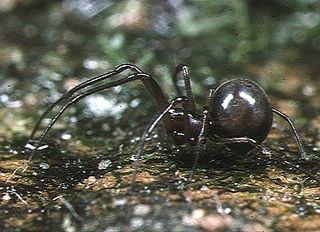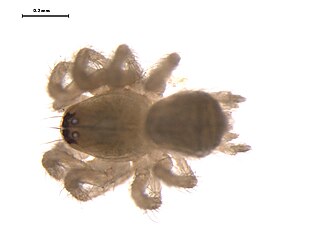
Oonopidae, also known as goblin spiders, is a family of spiders consisting of over 1,600 described species in about 113 genera worldwide, with total species diversity estimated at 2000 to 2500 species. The type genus of the family is OonopsKeyserling, 1835.

Corinnidae is a family of araneomorph spiders, sometimes called corinnid sac spiders. The family, like other "clubionoid" families, has a confusing taxonomic history. Once it was a part of the large catch-all taxon Clubionidae, now very much smaller. The original members of the family are apparently similar only in that they have eight eyes arranged in two rows, conical anterior spinnerets that touch and are generally wandering predators that build silken retreats, or sacs, usually on plant terminals, between leaves, under bark or under rocks.

Tegenaria is a genus of fast-running funnel weavers that occupy much of the Northern Hemisphere except for Japan and Indonesia. It was first described by Pierre André Latreille in 1804, though many of its species have been moved elsewhere. The majority of these were moved to Eratigena, including the giant house spider and the hobo spider.

Anapidae is a family of rather small spiders with 232 described species in 58 genera. It includes the former family Micropholcommatidae as the subfamily Micropholcommatinae, and the former family Holarchaeidae. Most species are less than 2 millimetres (0.079 in) long.

Harpactea is a genus of woodlouse hunting spiders that was first described by W. S. Bristowe in 1939. They are non-web building predators that forage on the ground and on tree trunks at night, mainly in xerothermic forests. During the day, they hide in silk retreats they build under rocks or bark.
Prethopalpus attenboroughi, or Attenborough's goblin spider, is a tiny spider named after Sir David Attenborough, that is found only on Horn Island off northern Queensland in Australia. The millimeter-long spider was described in 2012 by Dr Barbara Baehr of the Queensland Museum and Professor Mark Harvey of the Western Australian Museum.
Prethopalpus is a spider genus known as goblin spiders and are found in the Australasian tropics, including Nepal, India, Indonesia, Papua New Guinea and Australia. Three species are widely distributed, whereas the majority of species are recorded a single localities. Of the 41 species, 14 blind troglobite species live in subterranean ecosystems in Western Australia.
Prethopalpus maini is a subterranean goblin spider in the family Oonopidae.
Opopaea is a genus of goblin spiders of the family Oonopidae. The genus is one of the largest within the family, with 180 accepted species.
Prethopalpus blosfeldsorum is a litter-dwelling goblin spider in the family Oonopidae.
Prethopalpus marionae is a litter-dwelling goblin spider in the family Oonopidae.
Dasumia is a genus of woodlouse hunting spiders that was first described by Tamerlan Thorell in 1875.

Neoantistea is a genus of dwarf sheet spiders that was first described by Willis J. Gertsch in 1934.
Oonopoides is a genus of spiders in the family Oonopidae. It was first described in 1940 by Bryant. As of 2017, it contains 22 North American species.
Pelicinus is a genus of spiders in the family Oonopidae. It was first described in 1892 by Simon. As of 2022, it contains 21 species.
Toloonops is a genus of spiders in the family Oonopidae. It was first described in 2015 by Bolzern, Platnick & Berniker. As of 2017, it contains 7 species.
Storena is a genus of ant spiders first described by Charles Athanase Walckenaer in 1805.
Barbara Baehr is a German research scientist, entomologist, arachnologist, and spider taxonomist. She has described over 400 new spider species, mostly from Australia. She is originally from Pforzheim, Germany.





